
|   |

|   |
 e-mail: sunilkothari1933@gmail.com Rangayan Festival of Arts and Literature: A festival with a difference Photos: Arup Jyoti Kalita November 8, 2019 I have been visiting Guwahati for past several years on various occasions for research, documentation, conferences, lectures, attending Nritya Parva since 2000 when Sattriya was declared as eighth classical dance and after few years, Sattriya Kendra started arranging annual festival featuring senior and up and coming dancers, and symposiums. Since I was conducting research on Sattriya dances, I visited Guwahati and also other major cities and Sattras on Majuli Island. Over the years, I started following Assamese language and of course made friends. Finally Marg Foundation published my book on Sattriya dances of Assam with photographs by Avinash Pasricha. I had started working on Sattriya dances from 1964 and by 2013 the book was released in Guwahati. It brought me considerable recognition and I was conferred the most prestigious Madhavdev award this year. Working on Sattriya dances, extending its boundaries, discussing with Sharodi various aspects, often staying with her and her husband Dr. Dhrubajyoti Borah, currently Principal at Fakhruddin Ali Ahmed Medical College, Barpeta, and also a literary figure known for his trilogy (Kalantarar Gadya, Tejor Endhar, Artha), I was introduced to vast Assamese literature and the contemporary trends. 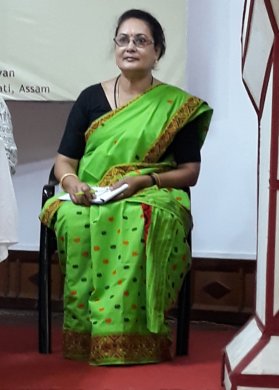 Sharodi Saikia (Pic: Sunil Kothari) Sharodi was trained in Sattriya from a young age, under Raseshwar Saikia, when he returned from Uttar Kamalabari Sattra and got married after leaving Sattra and settled in Guwahati, starting Sangeet Kendra teaching Sattriya to female dancers, a revolutionary step. Sharodi along with Indira PP Bora and others were the pioneering dancers. Whereas Indira PP Bora and others also studied Bharatanatyam, Sharodi specialized only in Sattriya. Like Sanjukta Panigrahi who inspired dancers in Odissi, Sharodi inspired young female dancers of Assam to learn Sattriya. Belonging to an erudite family, she also worked in Education Department. She was sent with President Fakhruddin Ali Ahmed when he visited Indonesia, to perform Sattriya dances. Sharodi arrived on national dance scene with her nomination to Executive Board of Sangeet Natak Akademi and performing in Delhi and elsewhere in India. We met often and she extended me all support for my research. During one critical period, she underwent treatment for brain tumour, but by God's grace she recovered and continued to dance. She also was appointed Director of Sankardev Kalakshetra for five years and gained lot of administrative experience. I have dealt in detail on her background, for many would not know how she had battled to survive and continued interacting with several disciplines. I know of no other dancer in Assam organizing such a festival titled Rangayan Festival of Art and Literature (RALF). Her booklet on profiles of luminaries titled Ranga Sampada is a collector's item giving in brief, information on the literary figures, painters, musicians, dancers, scholars and few supporters. This year more than 80 persons were involved in the festival during various sessions. Ranga Parampara 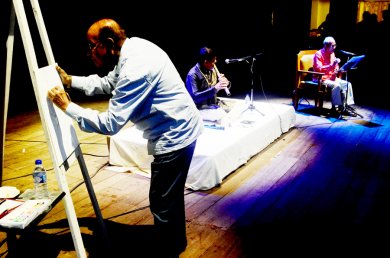 Dr. Irshad Ali, Chetan Joshi and Ratna Ojah The inaugural session Ranga Parampara on 22nd October at Madhavdev Auditorium was by three luminaries. Former Professor of Anthropology, Guwahati University, also a distinguished painter Dr. Irshad Ali, Ratna Ojah, a multifaceted personality, a poet, lyricist, playwright, novelist, actor, director, producer, singer, columnist and translator, and flutist Chetan Joshi, disciple of Pt Raghunath Seth, known for his unique style of performance, playing three and half octaves using a single flute, currently studying further under Pandit Ajoy Chakravorty. The three presented a unique presentation, a 'triveni sangam'. Ratna Ojah recited a poem in Assamese, Chetan Joshi played on flute swaras evoking the mood of the poem and Dr. Irshad Ali drew a painting with water colour showing the daily chores of tribal women. The experience aimed at inspiration derived from three different art forms, literature, painting and music by the gifted artists is unique. Even though brief, it brought three artists together and the audience was exposed to what these diverse art forms achieve when they work together simultaneously. Ojha Pali and Ram Natak 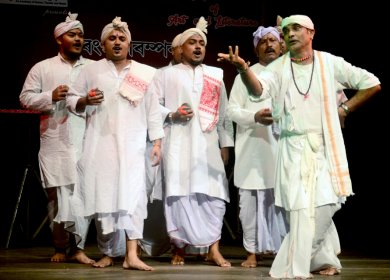 Ojha Pali Then followed the exposition of traditional arts from larger corpus of Sattriya dances, what is known as Ojha Pali. Led by Jatin Goswami's son Gunakar Goswami, a versatile dancer, singer, actor and director, the theme was from Padma Purana of story of Behula, the newly married couple. Under the curse of Manasa, the serpent goddess, the bridegroom was to die by the biting of the serpent goddess. Behula prays to Lord Shiva and regains the life of her husband. Gunakar as the lead Ojha, sang and danced and the four palis, back up musicians, played cymbals and sang along with Gunakar. Though the theme was Shaivite, each prologue shloka was in praise of Narayana, as there seemed to be confluence of Sukananni style of Ojha Pali. Gunakar explained to me that the first shloka is in praise of Krishna, showing river Yamuna and then singing the story which has Shaivite overtones. They all danced and performed with professional expertise. Then followed Ankiya Bhaona Ram Natak directed by Dipak Bora and performed by Abinaswar Gosthi troupe of Nagaon. The two incidents staged were Sita Haran and Bali Vadh. In typical Ankiya Bhaona dramatic form with Brajavali language, the actors took the audience to the familiar story of the epic Ramayana. It is said as long as there are mountains on earth and the rivers flow, the story of Rama will be remembered and enacted by people. 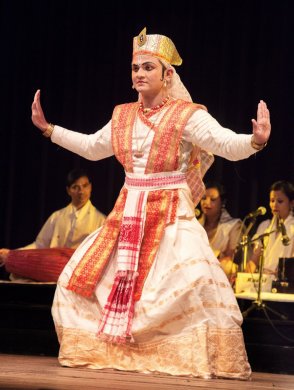 Sutradhar The Sutradhar entered the stage, danced and announced that they were to present Ram Natak. The entry of characters was done from behind the curtain, as is practice in other dance forms like Bhagavatamela Natakam, Kuchipudi and Yakshagana. The marriage scene is simply shown by Sita garlanding Ram and their coming to Ayodhya. Ravana does not appear attending swayamvara. After the marriage of Rama and Sita, Ram is banished to forest for fourteen years. Ram, Sita, Lakshman stay at Panchavati. Shurpanakha, sister of Ravana, sees Ram and is bewitched and approaches him. Ram tells her that he already has one wife, so go unto younger brother Lakshmana. Lakshmana is enraged and cuts off her nose and ears. She returns to Lanka crying and begs of Khar and Dushan to avenge her humiliation, but Lakshmana kills them when they come to attack him and Ram. Shurpanakha then tells Ravana that Ram needs to be taught a lesson and Ravana must possess the beautiful Sita. Ravana sends Maricha to entice Sita in form of a golden deer. Ram follows the golden deer (not shown in the play) but listening to Ram's cry, Sita begs of Lakshmana to go and save Ram. Lakshmana tells Sita that no one can hurt Ram, but she in anger taunts him that now Ram has gone he can have her for pleasure. She says, "Paranarilobhi, infatuated by another man's wife, you want to possess me. I curse you." The Brajavali dialogues are heartrending as Lakshmana listening to such accusations falls at her feet and goes away. Ravana comes in disguise as a mendicant and is unable to cross the line of fire - suggested by hand gestures. He asks Sita to come out to give alms and kidnaps her, encounters Jatayu and kills him and flies away to Lanka. Ram and Lakshmana see the slain Jatayu, who tells them that Ravana has kidnapped her.  Ram Natak Ram and Lakshmana walk further and see ornaments of Sita, meet Sugriva and seek his help. His elder brother Bali is seen fighting a demon and runs after him into a cave. Sugriva cries for help but Bali does not return. For a long time he waits and in order to save his wife and Bali's wife he rolls a huge boulder at the entrance of the cave. Meanwhile, Bali's wife and Sugriva's wife are seen together and Bali returning from the cave misunderstands that purposely Sugriva had blocked the entrance of cave so he could have his wife also. Sugriva tries to explain but Bali does not relent. Bali fights with Sugriva relentlessly as Hanuman and Jambavan watch helplessly. Ram shoots an arrow and kills Bali. Bali takes out his pearl necklace and puts round Sugriva to declare him as his successor and king after his death. This version was new for me. Chetan Joshi, the flutist, told me that this version is in Tulasidas's Ramcharitamanas. Ram Natak as presented ended with the killing of Bali. When the artistes deliver dialogues, sometimes it appears over the top, but the involvement of all actors including three female artistes was so intense, that the audience was glued to their seats almost under the spell. Both Ojha Pali and Ram Natak showed the Rang Parampara with traditional forms even now alive in Assam. The presentation was gripping and one realized how Sankardev used Brajbuli and created the form that spoke volumes to the audience. I have earlier seen Madhav Kandali's Assamese Ramayana. But this was different. Literary Forum: Seminar and Asmita-Forum of women writers Next morning on 23rd October was organized Literary Forum - Seminar on creative works of Sankardev to be followed by 'Asmita'- forum of women writers, at the seminar hall of Sankardev Kalakshetra. The Literary Forum was on 'Creative works of Sankardeva as an academic discipline.' One speaker was Dr. Karabi Deka Hazarika, former Professor and Dean of Humanities and Social Sciences at Dibrugarh University. She is one of the foremost contemporary women litterateurs of Assam. So far she has contributed 67 books, including 5 collections of poems like Subasiya ji Yantrana, Cchuli Nabandhiba, Yajnaseni, Porir Banhi, travelogues, children's books, literary criticism and translations. She has won prestigious Best Woman Writer Award of Asom Sahtiya Sabha. She mentioned the complexities of study of Sattriya and welcomed the need for a systematic approach for academic study. Trained in Sattriya dance, Khagen Sarma was originally offered as a child bhakta to Auniati Sattra, studied at Jorhat, taught as a lecturer at Jagirod College and obtained Ph.D from Guwahati University. His latest publication 'Glimpse of the Monastic Sattras of Assam' throws light on the monastic lives the monks lead. He is appointed as an examiner for Sattriya dance courses in various colleges. Dr. Pradip Jyoti Mahant is an academician, an authority on the institution of Sattras as a centre for creative arts and its two aspects, celibacy and grihasthashram - those who marry - the order and Sattras as centre for arts, study, literature, devotion, plays, Sattriya dances et al. As an academician he offered in his talk a broader view and referred to the contemporary writers, playwrights like Girish Karnad and interest those playwrights took in Sattriya culture. Pradip Jyoti Mahant's daughter Anwesa Mahanta is a brilliant Sattriya dancer. Guru Ghanakant Bora Gayan Bayan, Anwesa and Pradip Jyoti have contributed a lot in propagation of Sattriya dances.  Pitambar Dev Goswami, Sattradhikar of Auniati Sattra, Majuli Island, chairing the session expounding upon Sankardev's works Other speakers were Pona Mahant and Sanjeev Borkakati. In the chair was Pitambar Dev Goswami, Sattradhikar of Auniati Sattra on Majuli Island. He is a religious preacher, a Sattriya scholar and a zealous proponent of Sattriya philosophy. Born in 1959, he was brought to sattra as a young Govindpuriya, a novice at the age of ten. Well educated with Masters from Guwahati University, he is widely travelled and a skilled orator. He has delivered talks at UNESCO and in USA. He holds PhD on Sattriya subject from Dibrugarh Unversity. A Vyakaran Shastri in Sanskrit, he has written eight plays. Much respected Sattradhikar, he summed up the importance of academic course and syllabus for Sattriya at University level. Moderator Sanjib Kumar Sarma was a Professor of English at Dispur College holding a PhD from North Eastern Hill University, Shillong. His book 'Srimant Sankardev and Vaishnavite Movement of Assam' is an authoritative book on Sattras. A born editor, he has several distinctions to his credit. He is associated with All India Oriental Conference, Contemporary Literature Association of India, Assam Sahitya Sabha and Assam Natya Sammelan and has edited Ranga Sampada, booklet of the entire festival with introductions and life sketches of participants, which offers details of work done by scholars. He has also edited Rangalipi, an anthology of art and literature with articles in Assamese and English by scholars of various fields. It was a rare opportunity for some of us to meet these scholars and attend their deliberations on Sattriya dance form and Sattriya culture in general. The seminar focused on syllabus for critical studies of Sattriya which has found place in various universities and colleges in Assam. Since the papers presented were in English, it would be wonderful if they are edited and published during the course of the year. 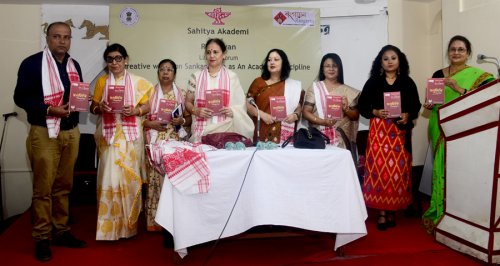 Asmita, the women poets' forum moderated by Mitra Phukan and release of Rangalipi edited by Dr. Sanjeev Sharma The next session was Asmita, a program on 'Reading of Assamese Poems and Short stories.' It was chaired by Mitra Phukan, an internationally known novelist, author, music critic, translator, and has a column 'Guwahati Gaze' and 'All things considered' in Assam Tribune. She also contributes to Sruti magazine and is known to readers outside Assam. Unfortunately, I could not attend that session where leading poets like Anupama Deka, Bonti Senchowa, Dipti Phukan Patgiri, Lufta Hanum, Salima Begum, Monalisa Saikia participated and read their poems and short stories. Of course the medium was Assamese language, therefore if in future the gist of the poems is given in advance or before the poems are read, it would have wider reach to persons coming from other cities. Fortunately, Ranga Sampada booklet contains enough biographical details of these women poets. Painting Workshop 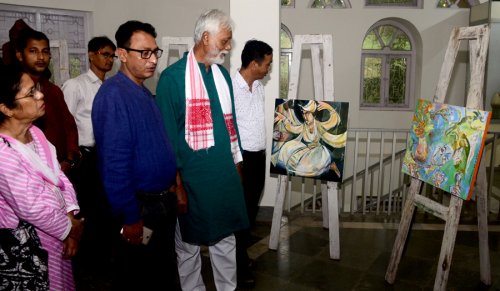 Famous artist Biren Singha inaugurating and admiring paintings made by senior artists the previous day Parallel to these two events from 10.30am, painting workshop was organized at Bakul Tol, artists' village at Sankardev Kalakshetra. It was coordinated by Kishore Kumar Das. Last year I had attended the workshop and met few painters who had studied at Faculty of Fine Arts from M.S.University of Baroda. I knew Kishore Kumar Das at Baroda, where he has exhibited his paintings at Space Gallery. A well known painter from Assam, he has participated in more than thirty joint exhibitions. It was quite an education to converse with him to know about where Assamese painters and paintings from Assam stand in all India world of painters and also abroad. Hiten Pathak, another noteworthy painter, is an artist in the Department of Pathology, Guwahati Medical College. He had participated in community painting at Sankardev Kalakshetra in 2001 and has been exhibiting in several exhibitions held in India. Aminul Haque, a self taught artist, is a science graduate from Guwahati University. Former president of Artists' Guild, he has participated in innumerable exhibitions in different parts of India. Besides he has also participated in National Art Fairs held in Delhi, Kolkata and Mumbai. A retired employee of Food Corporation of India, he is actively associated with art and cultural activities of Assam. Lutfa Akhtar has also studied at Baroda. She has participated in a number of exhibitions held in different cities of India, in Regional Painters' camp organized by Lalit Kala Kendra, Kolkata, and in the North East Panorama among others. Sarat Barua retired from the Directorate of Information and Public Relations as an art adviser. Trained in painting under late Tarun Duwara and Subha Brahma, his portraits of Bishnu Prasad Rabha and Hareswar Goswami are installed in the Assam Sate Legislative Assembly Picture Gallery. He has done murals of the North East in the arrival lounge of the Guwahati Airport. A Founder Member of Guwahati Artists' Guild, Sarat Barua has participated in several exhibitions across the country. Dilip Tamuly has passed the five year Fine Arts course from Shantiniketan with distinction. He also did two years course at the Royal Danish Academy, Denmark. He is a well known painter of Assam. Since these activities were held parallel to other events, it was difficult to attend the workshops. But the works were continuously displayed, so one could get a glimpse of them. The advantage was that the venues were in the same campus. It was a praiseworthy attempt to get all these artists to attend and participate in the painting workshop. The arrangements for lunch were made at the nearby restaurant in the campus. Screening of classic film 'Sandhya Raag'  Anupam Hazarika introducing the cast of film Sandhya Raag I had returned to the hotel after lunch and did not remember that there was a screening of an old Assamese classic Sandhya Raag by legendary Dr. Bhabendra Nath Saikia, at Banikanta Kakati Auditorium at 3pm. Luckily, Sharodi ensured that I reached the venue on time. It was a most moving film, often reminding me of Satyajit Ray's approach, the human touch, minimal dialogue, moving expressions on child actors and the village ambience. The story I was told was based on real incidents. It relates to young girls sent to cities to work as maids in middle class families, and how they grow up serving the upper class employees. The young girl who is sent to the city undergoes traumas in the beginning and then adjusts to the city life and work schedule. She often remembers her childhood and the village and her young companion, the games they used to play. It reminded me of Satyajit Ray's 'Pather Panchali' where small Apu runs around and plays with his sister. The young girl grows up and then is sent back to the village where with her other companion and old mother she starts working, but there is little that they can earn. Once for an event her former employers visit the village and meet her and feel happy to see her, but they do not know that the poverty the girls have to face is heart rending. Even though the print was old one, the photography was arresting and captured the mood well. The coordinator for the screening was Mr. Anupam Hazarika. Rang Mela One more event was Rang Mela for children at venue of steps leading to 'Snake Pillar'. The competition was held during the course of the festival and on the last day trophies were given to winners. I did not know exactly what the competition was about. However it was interesting to learn that young school going children were also involved in this festival. Rang Mukul 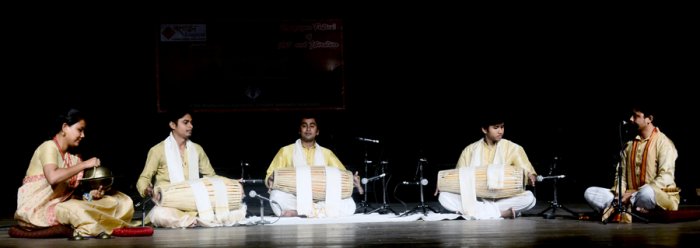 Sattriya Taal Vadya by Arunabh Jyoti Malakar, Biswajit Bardoloi, and Kankan Jyoti Saikia The evening's 'Rang Mukul' featured presentations of dance and music by upcoming artists at Madhavdev Auditorium. In the beginning, Sattriya Taal Vadya was presented by Arunabh Jyoti Malakar, the gifted percussionist grandson of Raseswar Saikia and son of Ranjumoni Saika, the Sattriya dancer. He was accompanied by two young khol players Biswajit Bardoloi and Kankan Jyoti Saikia. It was most impressive performance where they played reciting the mnemonic syllables of the khol competently. It was heartening to see the young generation devoting time seriously to master the art of khol playing. Arunabh Joyti Malakar is well versed and has it in his genes inheriting the art from his grandfather Raseswar Saikia. 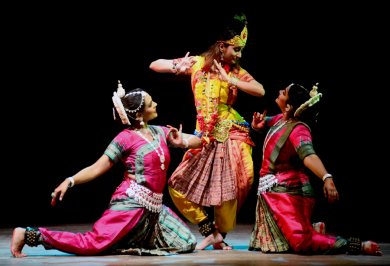 Disciples of Guru Mayadhar Raut From Delhi came three young Odissi dancers - Jayanti C. Sarmah, Priyanka Venkateswaran and Shruti Prasad - disciples of Guru Mayadhar Raut and his daughter Madhumita Raut. The three of them, with one wearing peacock feather crown and two others as Gopis created a pleasant group. In raag Bairagi, they presented pallavi which had old world charm. The compositions of Guru Mayadhar Raut were performed at leisurely pace bringing out the sculptural quality of Odissi and imaginative choreography of Guru Mayadhar Raut. The ashtapadi Lalita lavanga lata had its own charm and the abhinaya was enchanting. Of late one does not get opportunity to see from close quarters Guru Mayadhar Raut's choreography. Guruji's institution Jayantika is run by Madhumita with devotion and keeping the style of Guruji alive. 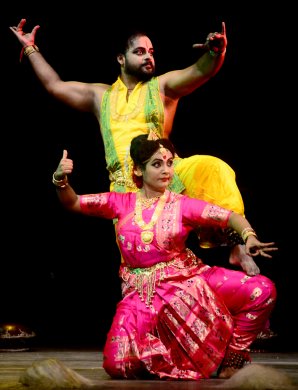 Ayan Mukherjee and Satabdi Acharya Dr. Mahua Mukherjee has been credited with creating Gaudiya Nritya. Her husband Amitava Mukherjee is an MA in Rabindrasangeet from Rabindra Bharati University and has received Senior Fellowship for research in Gaudiya Nritya from Ministry of Culture, Govt of India. He has gambhir voice and renders songs in arresting manner. He is Principal of Gaudiya Nritya Bharati institute. Mahua Mukherjee's son Ayan Mukherjee is skilled in Gaudiya Nritya, guitar and flute. He has received several medals for his performances of Gaudiya Nritya and has directed several dance and music compositions. Satabdi Acharya is a versatile dancer and choreographer. She holds PhD in dance from Rajashahi University, Bangladesh. Besides Gaudiya Nritya, she is proficient in folk dances, Chhau, Raibense, Natu and Nachni. She has also received several awards for Gaudiya Nritya. Ayan and Satabdi presented select items of Gaudiya Nritya, beginning with holding fly whisks in hand and dancing, also holding earthen pots and doing shashtanga danavata pranam evoking bhakti. Both are well trained dancers and created favourable impression for their duets. The prayer in praise of Shakti wove in both benign and ferocious expressions. The Leela Kirtan Nritya researched by Mahua from Mayadhar Vasu has typical flavour of Bengal Vaishnava Kirtan. Both performed Ardhanarishwara recreating the union of Shiva and Parvati. Ayan brought out the tandava aspect whereas Satabdi the lasya aspect with Úlan and competence. Set in raag Malkauns, it was well received. In finale, Satabdi performed Puthana moksham in Gaudiya style. Sent by Kansa to kill child Krishna, Puthna dresses herself as a beautiful gopi and comes to house of Vasudev and seeing Krishna, falls in love with the divine child. But she remembers her mission and applying poison on her breasts, she takes Krishna to feed him. Krishna in the beginning pretends to drink milk but then sucks out her life and Puthana dies revealing her demon form. It was quite dramatic. 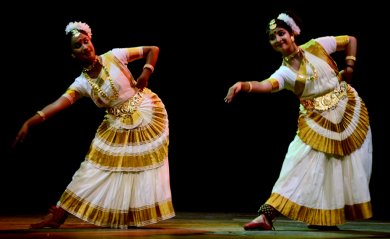 Malavika Ajit Kumar and Revathi R Nair From Delhi arrived Malavika Ajit Kumar and Revathi R Nair, two sprightly dancers performing Mohiniattam. Disciples of Dipti Bhalla, they charmed the audience by their graceful dance. Choreographed by Dipti Bhalla, the prayer to Krishna in 'Adi Keshava namami', based on Nritya Prabandha, the iconic form of Vishnu with gada, chakra, conch and lotus took shape before one's eyes. The composition relates to a place of pilgrimage and the temple of Adi Keshava. The Pancha matra guru laghu, guru laghu and the use of mnemonic syllables lent extra texture to the movements. The gradual rising of the pace was interesting. The incorporation of Dashavatar enriched the item in terms of choreography. In concluding number Shivachali, the mnemonic syllable struck on mridangam was hypnotic and had all the elements of devotion. Both the dancers performed with complete involvement bringing out the typical grace of Mohiniattam. In North East, Mohiniattam is rarely seen. Both dancers did their guru proud. To encourage young dancers under this format of the program, two dancers Shristy Bhattacharya and Darshana Sarma were invited to perform Kathak. Their prayer Sri Ramachandra krupalu bhaja mana of Tulasidas in Sanskrit was rendered with devotion. They looked very innocent and naive because of their age. But their involvement while performing was captivating. The nritta included tode, tukde and parans and were executed with confidence. Disciples of Guru Srivastava, they both have been groomed well in the Kathak medium. Muktangan 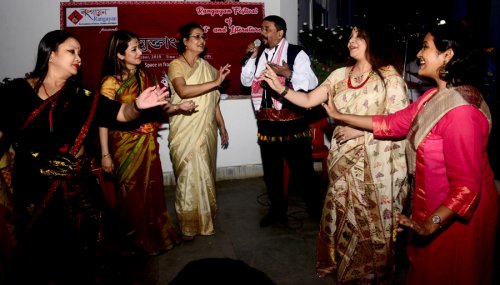 Muktangan On the final day at 3pm, the most spontaneous program was Muktangan, at the open space in front of Snake Pillar. It was in nature of Open House discussion. The moderators were Robin Kalita and Snigdha Sikha Borah Chaudhury. Robin Kalita is an excellent quiz master, actor, anchor and a sports organizer of repute. He is an advisor for Transport AIWTDS, Government of Assam. Snighdha Sikha Borah Chaudhury is a senior producer and anchor with DY365 and anchor with Akashvani, Dibrugarh. A visharad from Bhatkhande Vidyapith, Lucknow, she has acted in various plays and numerous TV serials. Both the moderators knew their job well. 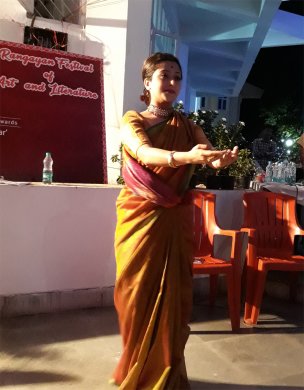 Meghranjani Medhi (Pic: Sunil Kothari) From among the participants were leading literary figures, actors, playwrights and corporate persons. The local dancers included Meerananda Borthakur, Anita Sharma, Marmi Medhi and her daughter brilliant Kathak dancer Meghranjani Medhi and from outstation, artistes Mahua Mukherjee and she husband Amitava Mukherjee. Chetan Joshi, the flutist and Manjari Sinha, the music and dance critic came from Delhi. It was also Sharodi Saikia's birthday and when it became known, there was a small celebration. Robin Kalita with his usual flair started asking questions to the corporate persons about how they got interested in art. It was interesting that someone in the family knew dance and therefore they also got involved with dance and music. The actress when questioned started laughing, and she with her acting ability laughed so much uninterrupted that we all joined her. There was a former film actress from film Sandhya Raag, who when asked about how did she land up getting the role in the film, explained that the director asked her to dance when auditioning her. Then she danced without inhibition and created old world charm. Some were asked to sing, Amitava Mukherjee sang 'Sahanau bhunaktu, saha viryam karavavahai' Rigvedic prayer in his deep bass voice and Robin Kalita knowing that his wife was Mahua Mukherjee, asked her to dance and many dancers joined her. Meghranjani Medhi, young and charming, performed Kathak in praise of Ganapati, whereas Meerananda Borthakur performed to Bhupen Hazarika's well known song 'Dil hun hun kare'. Anita Sharma danced to a contemporary Assamese popular poem. The lady artistes sang songs which were known to most of the persons and they joined in chorus. It was like 'letting hair down' for all. Rarely such a crowd gets together like this and it was indeed highly enjoyable. Ranga Nidhi The grand finale was at Madhavdev Auditorium. It consisted of Sur Samalaya. The shehnai vadan set the auspicious mood. The dance performances were by Aruna Mohanty (Odissi), Rama Vaidyanathan (Bharatanatyam) and Meenu Thakur (Kuchipudi). 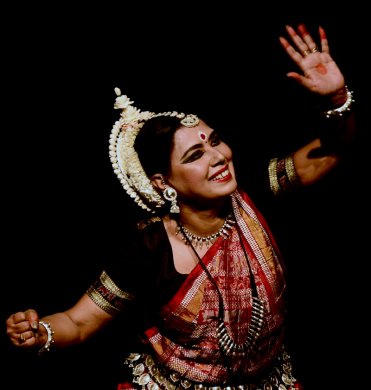 Aruna Mohanty Aruna Mohanty from Bhubaneswar presented with live accompaniment, her well known work in Odissi, Nayak and Pratinayak. The poet Kedar Sharma and she have worked on this theme which has received critical acclaim. Aruna has been always exploring new themes and thinks out of the box. The existential saying 'I am there for you are' has found felicitous expression taking the heroes and anti heroes from mythology: Hiranyakashipu and Narasimha, Ravana and Rama, Kansa and Krishna and in present times, it is 'time' 'kaala' which has both the aspects. Aruna enacts them with competence revealing their strengths. I have reviewed this choreographic work in my earlier reviews in Narthaki.com, as I happened to see it more than three times. It was quite revealing for local Odissi dancers who found it fascinating. Instead of the usual fare of Pallavi and Gita Govinda ashtapadis, this exploration and pushing the boundaries of Odissi won Aruna many admirers. 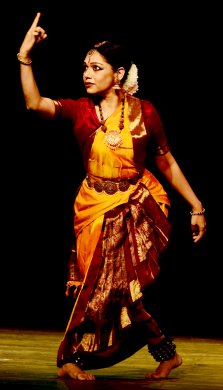 Rama Vaidyanathan Rama Vaidyanathan also presented an unusual choreographic work based on Guru Nanak's composition. The Dashavastha, what the ten stages of amoeba when in embryo experiences and goes through was enacted with exemplary finesse. The opening position of embryo was imaginative. As human beings grow, what they want in childhood, when they grow, the kumaravastha wanting recognition from friends, youth, attraction for opposite sex, middle age, and leading towards old age, how the human being undergoes different feelings and experience and says 'Nahi, Nahi' he does not want to go through all this again and again. Rama has given a lot of thought while choreographing this work and has in her inimitable way added to her repertoire themes which are not run of the mill, but are provocative and makes one ponder over the mysteries of life cycle and philosophical reflections. Sharodi wanted to bring the unusual aspect of Kuchipudi extolling the goddess astride lion, Simhanandini. This is a rare item in Kuchipudi repertoire. Late Guru CR Acharyalu was renowned for these items. The dancer while dancing to the Simhanandini tala, performing on a canvas spread on the floor, draws an image of a lion with her toe while dancing. On the floor is spread red powder which helps the dancer to draw the outline. 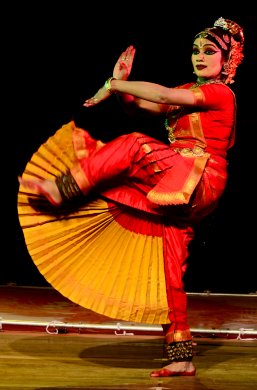 Meenu Thakur Meenu Thakur, a disciple of Swapnasundari, later on studied under Guru Jayarama Rao and Vanashree Rao. This particular item she has studied from Voleti Rangamani, daughter of Acharyalu. Performing in the beginning a prayer in praise of the goddess, she evoked her benign and ferocious aspects. The typical up and down, bobbing movements of Kuchipudi were executed by Meenu competently. There is a delectable lilt in Kuchipudi which is quite charming. To simhanandini tala recitation, Meenu danced on the canvas and at the end of the dance, when the cloth framed to the iron bars was raised, the painting of lion was shown to the audience. They applauded it with a sense of wonder. For audience in Guwahati this item was quite a surprise so it was important to bring such dance gems in a festival of multi-arts. Sharodi's younger sister Shantana Saikia did a good job of compering the festival. She is a Professor in English at Bahona College at Jorhat. Her areas of interest are ethnographic research. She has researched on oral narratives of ethnic communities from sociological perspective. She has also published widely on the narratives of Sattras of Assam and holds a Ph.D on that subject. It was a pleasure to meet her and exchange views with her on Sattras. Conclusion and suggestions For such a marathon festival, at the very outset we would like to compliment Sharodi Saikia for her enterprise. However, in spite of several associates extending her support, there happened several glitches which in future she would do well to avoid. The concept is praiseworthy and needs to be followed as it brings diverse people together. Such an ambitious project needs lot of organizational support. Despite all good intentions, time was the first casualty. One can understand delays, but most of the time the performances started nearly an hour late. With the contemporary lifestyle, the delayed programs saw few in the audience. People left when it got late. Therefore, the idea of exposing the audiences to reputed artistes and other forms got defeated. To see few people in auditorium was disheartening. Once the programs start on time, the audience will know what they would miss if they do not go on time. It seems there were problems to get invitations in time. What was announced with photos of dancers had no details of venue and timing. Many therefore did not know who were performing and on what dates. Today with Facebook, whatsapp, instagram and twitter, the communication is easy. Rangayan has to put it on its social media (if Sharodi has not so far, she must create urgently) and follow a slew of publicity from well before the event. The dancers invited should in turn put it on their social media and inform their friends in Guwahati. Sharodi would have to take this on a war footing with help of her associates. Sharodi said that the printing was delayed and invitations did not arrive in time. But today few wait for receiving invitations by post. This lacuna also contributed to a poor turnout. These are harsh facts and as an organizer with such a wonderful team of persons, writers, poets, painters, literary giants, whose goodwill Sharodi enjoys over the years, she will have to attend to these matters first. We all know that sponsors do not send confirmations on time. But in spite of that once the artists are firmed up, the email invites and social media publicity should go viral. The booklets Sharodi gets edited and printed are a mine of information about the distinguished participants and are like collector's items. But they need to be handed over to visiting scholars, critics and dancers on their arrival with all details about the performances. Whenever possible, assistants are to be entrusted to look after the visiting dancers and scholars so that they do not miss out on important events. I am sure Sharodi is aware of these hurdles. She now has to tackle these issues and turn this much awaited festival into a resounding success.  Dr. Sunil Kothari is a dance historian, scholar, author and critic, Padma Shri awardee and fellow, Sangeet Natak Akademi. Dance Critics' Association, New York, has honoured him with Lifetime Achievement award. Post your comments Please provide your name and email id when you use the Anonymous profile in the blog to post a comment. All appropriate comments posted with name and email id in the blog will also be featured in the site. |